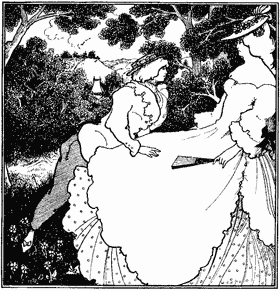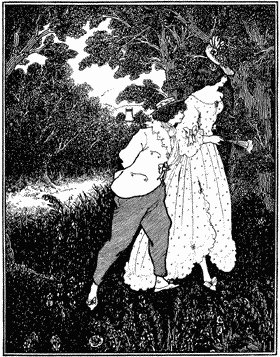
The Three Musicians
 |
|
The Three Musicians - first version
|
Along the path that skirts the wood,
The three musicians wend their way,
Pleased with their thoughts, each other’s mood,
Franz Himmel’s latest roundelay,
The morning’s work, a new-found theme,
their breakfast and the summer day.One’s a soprano, lightly frocked
In cool, white muslin that just shows
Her brown silk stockings gaily clocked,
Plump arms and elbows tipped with rose,
And frills of petticoats and things, and outlines
as the warm wind blows.Beside her a slim, gracious boy
Hastens to mend her tresses’ fall,
And dies her favour to enjoy,
And dies for réclame and recall
At Paris and St. Petersburg, Vienna and St. James’s Hall.The third’s a Polish Pianist
With big engagements everywhere,
A light heart and an iron wrist,
And shocks and shoals of yellow hair,
And fingers that can trill on sixths and fill beginners with despair.The three musicians stroll along
And pluck the ears of ripened corn,
Break into odds and ends of song,
And mock the woods with Siegfried’s horn,
And fill the air with Gluck, and fill the tweeded tourist’s soul with scorn.
 |
|
The Three Musicians - published version
|
The Polish genius lags behind,
And, with some poppies in his hand,
Picks out the strings and wood and wind
Of an imaginary band,
Enchanted that for once his men obey
his beat and understand.The charming cantatrice reclines
And rests a moment where she sees
Her chateau’s roof that hotly shines
Amid the dusky summer trees,
And fans herself, half shuts her eyes, and
smoothes the frock about her knees.The gracious boy is at her feet,
And weighs his courage with his chance;
His fears soon melt in noon-day heat.
The tourist gives a furious glance,
Red as his guide-book grows, moves on,
and offers up a prayer for France.
¶ 1895. First published in The Savoy, No.1, Jan 1896. Written during the Summer of 1895 at Arques-la-Bataille and in Dieppe. Arthur Symons described the verses as being “in their own way, a tour de force,” but peevishly added that they revealed only that Aubrey had succeeding “in doing what he certainly had no aptitude for doing.” According to a highly unlikely legend, the first version of the drawing made to accompany these verses was censored by Leonard Smithers, who is reputed to have thought the pose of the young man, with his hand upon the girl’s knee, too suggestive.
